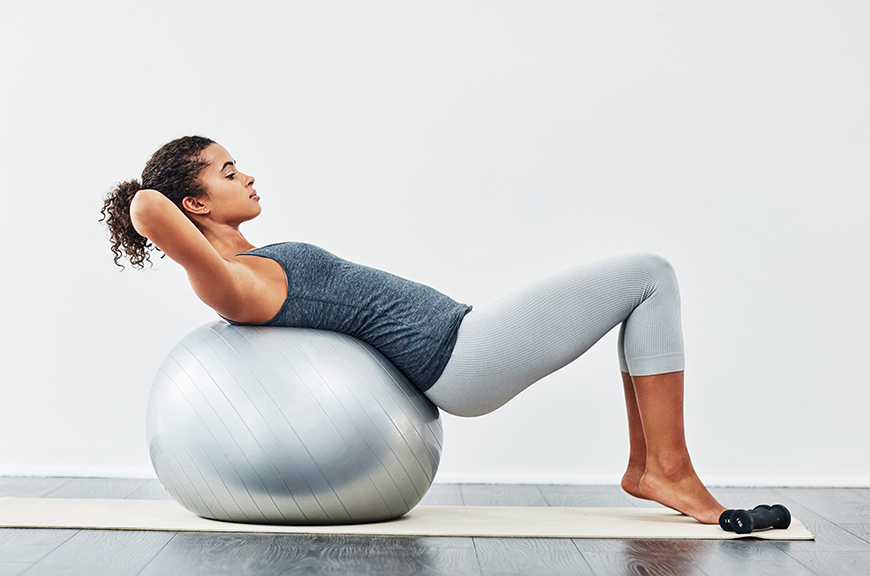
February 09, 2020 at 12:00PM by CWC
Exercise balls are primarily used for, well, exercising. You can use them for strengthening your core, improving your stability, and toning your arms. They’re not just great for all things fitness, though—they’re also a super underrated way to stretch your lower back, not to mention help reverse all the damage from sitting at a desk all day.
“Over the course of the day, the effects of gravity and poor posture cause compression through the vertebral segments, from neck to sacrum, and the spinal discs. It also places muscles and joints in disadvantageous positions,” says Danielle Weis, DPT, a physical therapist and orthopedic clinical specialist at Spring Forward Physical Therapy. “Longterm—as little as 3 to 6 months—prolonged posturing and inflexibility causes the muscles around the spine to get tight and the spine itself becomes compressed and stiff between each segment. As we age, compression can worsen and disc health can become compromised, setting us up for future injury.”
Taking the time to help out your lower back now is a must—and you can easily do so with your exercise ball. According to Weis, it’s a great way target both joint mobility and muscle flexibility at once. “It also allows for easy modification. You can take a stretch deeper or keep it light, depending on your needs and exercise tolerance,” she says. “An exercise ball, since it’s air-filled, also provides a comfortable surface to stretch on. Aka the opposite of a foam roller.”
The best ways to stretch your lower back with an exercise ball
ADVERTISEMENT
ADVERTISEMENTKate Spade Autumn/Winter Sale |
To help decompress the lower back, Weis recommends stretching the tight muscles in and around the back, as well as mobilizing the spine. To get started, hold each of these stretches in a pain-free position for a few rounds of 30 seconds each.
1. Lay back over the ball
This stretch will feel especially good for anyone who’s stuck in a cubicle all day. “It creates a stretch through the front of the body—mainly the abdominals and iliopsoas muscles—which get tight with sitting at a desk, as we hunch forward through the day,” Weis says. “This also allows the spine to mobilize and reverse the upper back’s natural ‘kyphotic’ curve, which can become overly rounded with poor posture. It’s an easy stretch, but it’s highly affective.”
How to do it:
- Keeping your feet flat on the floor, lay down with your back against the ball.
- To deepen the stretch, reach your hands overhead and try and touch the floor.
2. Stretch forward over the ball
This stretch—which is kind of like child’s pose, TBH—creates a stretch through your upper back joints, which “reverses the natural rounding of the upper and mid-back, which become overly rounded due to many common activities of daily life,” says Weis. That includes working, reading, texting… basically everything.
How to do it:
- Position yourself on your knees, face the ball, and put your forearms on top of the ball.
- Reach forward with your arms then gently drop down your head and upper back so your hands are positioned higher.
- To add a little more, reach arms slightly to the right and hold, then left and hold. Bringing in side bending and rotation adds another element of spinal opening to the stretch, as well as adding in a stretch for the lats.
3. Lay on your side over the ball
You draped backward over the ball. Now, you’ll do the same thing facing the side. “This opens the vertebral joints on the ‘top’ side of the body and stretches out the muscles, including the lats, paraspinals, quadratus lumborum, and glutes,” Weis says. “Just make sure to stretch both sides.”
How to do it:
- Face sideways and lay your side body over the ball, keeping your feet on the floor.
- Bring your bottom hand to the floor to help stabilize yourself, then bring your top hand to your head as you relax sideways over the ball.
- To deepen the stretch, reach your top hand all the way up and over, as if you’re trying to reach the floor.
4. Sit on top of the ball
Another good stretch is using the ball is for the hips, Weis says. “This stretches both the long paraspinal muscles in the back, as well as the hip of the crossed leg,” she notes.
How to do it:
- Sit atop the ball and cross one ankle over the opposite knee.
- Reach forward, bringing your shoulders as close to your crossed leg as you can, dropping your head down.
- Reach forward all the way to the ground to deepen.
5. Do a wall sit with the ball
Wall sits aren’t fun, but doing one with an exercise ball can bring on some benefits. “It creates a stretch through the pecs, opening the front of the body and shoulders, as well as mobilizing the spine to extension,” Weis says.
How to do it:
- Place a ball against a wall to stabilize before you begin.
- Squat down and place your back up against the side of the ball toward the top.
- Bring arms to a “goal post” position and reach your arms back as you lean back into the ball.
Do this relaxing stretch routine before you go to bed:
ADVERTISEMENT
ADVERTISEMENTSports Direct Free Delivery on All Orders! |
These are the three best stretches to soothe swayback posture, according to a physical therapist. Then try the “scorpion stretch,” which gives hips, low back, and hamstrings a triple release.
Author Tehrene Firman | Well and Good
Selected by CWC

ADVERTISEMENT
ADVERTISEMENTUp to 30% off Gift Sets |







